
In botany, the radicle is the first part of a seedling to emerge from the seed during the process of germination. The radicle is the embryonic root of the plant, and grows downward in the soil. Above the radicle is the embryonic stem or hypocotyl, supporting the cotyledon(s).
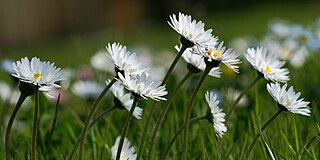
A tropism is a biological phenomenon, indicating growth or turning movement of a biological organism, usually a plant, in response to an environmental stimulus. In tropisms, this response is dependent on the direction of the stimulus. Viruses and other pathogens also affect what is called "host tropism", "tissue tropism", or "cell tropism"; in which case tropism refers to the way in which different viruses/pathogens have evolved to preferentially target specific host species, specific tissue, or specific cell types within those species. Tropisms are usually named for the stimulus involved and may be either positive or negative. Positive tropisms, which are the majority of tropisms, are called "orthotropisms", and negative tropisms are called "plagiotropisms".

Sir Francis "Frank" Darwin was a British botanist. He was the third son of the naturalist and scientist Charles Darwin.
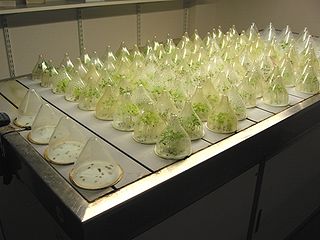
Plant physiology is a subdiscipline of botany concerned with the functioning, or physiology, of plants. Closely related fields include plant morphology, plant ecology, phytochemistry, cell biology, genetics, biophysics and molecular biology.

Phytochromes are a class of photoreceptor in plants, bacteria and fungi used to detect light. They are sensitive to light in the red and far-red region of the visible spectrum and can be classed as either Type I, which are activated by far-red light, or Type II that are activated by red light. Recent advances have suggested that phytochromes also act as temperature sensors, as warmer temperatures enhance their de-activation. All of these factors contribute to the plant's ability to germinate.

Coleoptile is the pointed protective sheath covering the emerging shoot in monocotyledons such as grasses in which few leaf primordia and shoot apex of monocot embryo remain enclosed. The coleoptile protects the first leaf as well as the growing stem in seedlings and eventually, allows the first leaf to emerge. Coleoptiles have two vascular bundles, one on either side. Unlike the flag leaves rolled up within, the pre-emergent coleoptile does not accumulate significant protochlorophyll or carotenoids, and so it is generally very pale. Some preemergent coleoptiles do, however, accumulate purple anthocyanin pigments.

Heliotropism, a form of tropism, is the diurnal or seasonal motion of plant parts in response to the direction of the Sun.
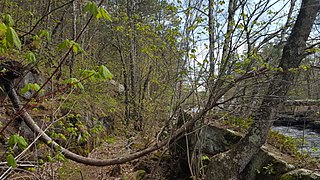
Gravitropism is a coordinated process of differential growth by a plant in response to gravity pulling on it. It also occurs in fungi. Gravity can be either "artificial gravity" or natural gravity. It is a general feature of all higher and many lower plants as well as other organisms. Charles Darwin was one of the first to scientifically document that roots show positive gravitropism and stems show negative gravitropism. That is, roots grow in the direction of gravitational pull and stems grow in the opposite direction. This behavior can be easily demonstrated with any potted plant. When laid onto its side, the growing parts of the stem begin to display negative gravitropism, growing upwards. Herbaceous (non-woody) stems are capable of a degree of actual bending, but most of the redirected movement occurs as a consequence of root or stem growth outside. The mechanism is based on the Cholodny–Went model which was proposed in 1927, and has since been modified. Although the model has been criticized and continues to be refined, it has largely stood the test of time.

Charles Robert Darwin was an English naturalist, geologist and biologist, best known for his contributions to evolutionary biology. His proposition that all species of life have descended from common ancestors is now widely accepted and considered a fundamental concept in science. In a joint publication with Alfred Russel Wallace, he introduced his scientific theory that this branching pattern of evolution resulted from a process that he called natural selection, in which the struggle for existence has a similar effect to the artificial selection involved in selective breeding. Darwin has been described as one of the most influential figures in human history, and he was honoured by burial in Westminster Abbey.
This is a partial list of the writings of Charles Darwin, including his main works.

Astrobotany is an applied sub-discipline of botany that is the study of plants in space environments. It is a branch of astrobiology and botany.

Nutation refers to the bending movements of stems, roots, leaves and other plant organs caused by differences in growth in different parts of the organ. Circumnutation refers specifically to the circular movements often exhibited by the tips of growing plant stems, caused by repeating cycles of differences in growth around the sides of the elongating stem. Nutational movements are usually distinguished from 'variational' movements caused by temporary differences in the water pressure inside plant cells (turgor).

Insectivorous Plants is a book by British naturalist and evolutionary theory pioneer Charles Darwin, first published on 2 July 1875 in London.

The Variation of Animals and Plants under Domestication is a book by Charles Darwin that was first published in January 1868.

TROPI, or "Analysis of a Novel Sensory Mechanism in Root Phototropism", is an experiment on the International Space Station (ISS) to investigate the growth and development of plant seedlings under various gravity and lighting combinations. It was launched on Space Shuttle Endeavour during the STS-130 mission and was performed on the ISS during Expedition 22. Frozen plant samples from the TROPI experiment were returned on the landing of the STS-131 mission on Space Shuttle Discovery.

Dr. Julius Ritter von Wiesner was a professor of botany at the University of Vienna, a specialist in the physiology and anatomy of plants.
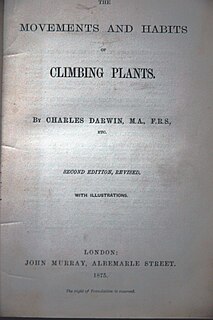
On the Movements and Habits of Climbing Plants is a book by Charles Darwin first printed in book form in 1875 by John Murray. Originally, the text appeared as an essay in the 9th volume of the Journal of the Linnean Society, therefore the first edition in book form is actually called the ‘second edition, revised.’ Illustrations were drawn by Charles Darwin’s son, George Darwin.
The Different Forms of Flowers on Plants of the Same Species is a book by Charles Darwin first published in 1877. It is the fifth of his six books devoted solely to the study of plants.

In botany, the Cholodny–Went model, proposed in 1927, is an early model describing tropism in emerging shoots of monocotyledons, including the tendencies for the shoot to grow towards the light (phototropism) and the roots to grow downward (gravitropism). In both cases the directional growth is considered to be due to asymmetrical distribution of auxin, a plant growth hormone. Although the model has been criticized and continues to be refined, it has largely stood the test of time.
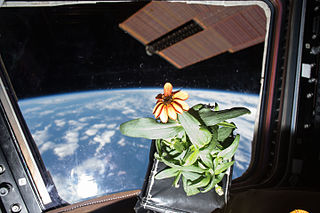
The growth of plants in outer space has elicited much scientific interest. In the late 20th and early 21st century, plants were often taken into space in low Earth orbit to be grown in a weightless but pressurized controlled environment, sometimes called space gardens. In the context of human spaceflight, they can be consumed as food and/or provide a refreshing atmosphere. Plants can metabolize carbon dioxide in the air to produce valuable oxygen, and can help control cabin humidity. Growing plants in space may provide a psychological benefit to human spaceflight crews. Usually the plants were part of studies or technical development to further develop space gardens or conduct science experiments. To date plants taken into space have had mostly scientific interest, with only limited contributions to the functionality of the spacecraft, however the Apollo Moon tree project was more or less forestry inspired mission and the trees part of a country's bicentennial celebration.

















